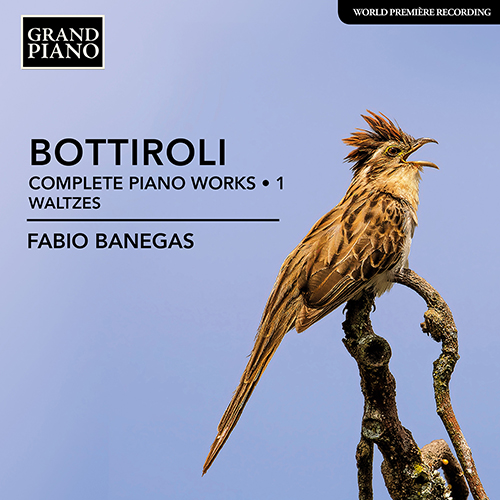
About this Release
“One of the most amazing experiences a musician can have is to learn the works of a composer with the composer. It goes far beyond the mere learning of the instrument, as one encounters the most profound essence and deepest understanding of the artist. This is exactly what happened to me when I was a teenager and met José Antonio Bottiroli. As his only piano student, I felt the duty to keep his music alive while faithfully rendering my own interpretation of the essence of his music.” — Fabio Banegas
BOTTIROLI, JOSÉ ANTONIO (1920–1990)
Complete Piano Works • 1
Waltzes
- Fabio Banegas, piano
Argentinian composer, poet and teacher José Antonio Bottiroli found his ideal means of expression in the Romantic idiom and in shorter forms of music. Exploiting the rich resources of the waltz, his pieces are infused with a remarkable range of moods, intimacies, real-life experiences and scenes from nature, as well as portraits of children and loved ones, such as the iconic Verdadero in honour of the composer’s wife—all played with the unique insights of his student and protégé Fabio Banegas.
This recording was made on: Steinway, Model D, number 559445
Tracklist
|
1
Waltz in G Major, B23 (1971) (00:02:55)
|
|
2
Waltz in E Minor, B27, "Verdadero" (True) () (00:03:51)
|
|
3
Waltz in F Minor, B30, "Chopin" (1974) (00:03:27)
|
|
4
Vals etopeya (Waltz Ethos) in G-Flat Major, B34, "Mario" (1974) (00:04:25)
|
|
5
Waltz in D Major, B43 (1975) (00:03:34)
|
|
6
Waltz in D-Flat Major, B46, "Inspirado" (Inspired) (1976) (00:03:55)
|
|
7
Waltz in G Minor, B61 (1978) (00:01:34)
|
|
8
Waltz in D-Flat Major, B63 (1978) (00:02:37)
|
|
9
Waltz in D-Flat Major, B64 (1978) (00:02:40)
|
|
10
Waltz in F Major, B67 (1978) (00:02:54)
|
|
11
Waltz in A-Flat Major, B72, "Test Vals" (Test Waltz) (1979) (00:02:12)
|
|
12
Waltz in G-Flat Major, B86 (1981) (00:03:22)
|
|
13
Waltz in E-Flat Major, B93 (1984) (00:02:20)
|
|
14
Waltz in E-Flat Major, B94 (1984) (00:02:52)
|
|
15
Waltz in E-Flat Major, B101 (1985) (00:02:46)
|
|
10 Microvalses (Microwaltzes), B42 (1976) (00:04:00 )
|
|
16
No. 1 in B Minor, "Nono Nicolás: Cacique" (Grandpa Nicolás: The Tribe's Chief), B114, No. 1 (00:00:23)
|
|
17
No. 2 in G-Flat Major, "Nona Orlanda: Su mujer" (Grandma Orlanda: His Wife), B114, No. 2 (00:00:22)
|
|
18
No. 3 in D Major, "Hija I: Bolichera en Puntas" (Daughter I: Party Girl), B114, No. 3 (00:00:21)
|
|
19
No. 4 in G Major, "Hija II: Secretaria de tribu" (Daughter II: Tribe's Secretary), B114, No. 4 (00:00:19)
|
|
20
No. 5 in D Minor, "Yerno: Requerido por la Poli" (Son in Law: Wanted by the Police), B114, No. 5 (00:00:21)
|
|
21
No. 6 in D-Flat Major (00:00:21)
|
|
22
No. 7 in E Major (00:00:24)
|
|
23
No. 8 in F-Sharp Minor, "Nieta II: ¿Qué pasa, señor?" (Granddaughter II: What's Going On, Sir?), B114, No. 7 (00:00:17)
|
|
24
No. 9 in E Minor, "Nieta I: ¡Ojo, terremoto!" (Granddaughter I: Be Careful, Earthquake!), B114, No. 6 (00:00:27)
|
|
25
No. 10 in A Minor (00:00:33)
|
|
26
Papirola in D Major, B38 (1974) (00:03:34)
|
|
27
Piruchín in F Major, B65, "Página" (Leaf) (1978) (00:02:32)
|
|
28
Pájaro invisible (Invisible Bird) in A-Flat Major, B68, "Crespín" (Striped Cuckoo) (1979) (00:01:45)
|
|
29
Payasos in F Major, B89, "Clowns" (1982) (00:01:56)
|
|
30
Paráfrasis sobre un tema de Anton Arensky (Paraphrase on a theme by Anton Arensky), B90 (1982) (00:04:48)
|
The Artist(s)
 Classical pianist, music scholar and editor, Fabio Banegas, has appeared in recitals and as soloist in the United States, Europe and in his native Argentina. He studied at the National University of Rosario (UNR) where he obtained two degrees: Piano Performance and the National Professorate of Music. He continued his education in the United States earning a Master of Music (MM) at California State University Fullerton (CSUF) under Dr Susan Svrček. Fabio Banegas is an interpreter of the complete piano works by the Argentinean composer José Antonio Bottiroli, of whom he was a student, and has given world premières of many of the composer’s works. He is a recipient of many awards, most notably, from Argentina, the Friends of the Arts of Rosario Award and the Mozarteum Santa Fe Music Award; and from the US, the Redfield Award of the Orange County Philharmonic Society and the Phi Beta Delta Internationalist Award.
Classical pianist, music scholar and editor, Fabio Banegas, has appeared in recitals and as soloist in the United States, Europe and in his native Argentina. He studied at the National University of Rosario (UNR) where he obtained two degrees: Piano Performance and the National Professorate of Music. He continued his education in the United States earning a Master of Music (MM) at California State University Fullerton (CSUF) under Dr Susan Svrček. Fabio Banegas is an interpreter of the complete piano works by the Argentinean composer José Antonio Bottiroli, of whom he was a student, and has given world premières of many of the composer’s works. He is a recipient of many awards, most notably, from Argentina, the Friends of the Arts of Rosario Award and the Mozarteum Santa Fe Music Award; and from the US, the Redfield Award of the Orange County Philharmonic Society and the Phi Beta Delta Internationalist Award. The Composer(s)
 José Antonio Bottiroli’s music emerged in stark contrast within the Argentinean classical landscape created by his predecessors, as he did not find inspiration in folklore and native dances. He also diverged from the modernist and avant-garde musical aesthetic adopted by many of his contemporaries. Instead, he found in the short musical forms of Romanticism the ideal medium for his expression, which he infused with diverse moods, extreme subjectivism, intimacy and his own real-life experiences.
José Antonio Bottiroli’s music emerged in stark contrast within the Argentinean classical landscape created by his predecessors, as he did not find inspiration in folklore and native dances. He also diverged from the modernist and avant-garde musical aesthetic adopted by many of his contemporaries. Instead, he found in the short musical forms of Romanticism the ideal medium for his expression, which he infused with diverse moods, extreme subjectivism, intimacy and his own real-life experiences. 


 Grand Piano has gained a reputation for producing high quality recordings of rare keyboard gems. Dedicated to the exploration of undiscovered piano repertoire, the label specialises in complete cycles of piano works by many lesser-known composers, whose output might otherwise have remained unknown and unrecorded.
Grand Piano has gained a reputation for producing high quality recordings of rare keyboard gems. Dedicated to the exploration of undiscovered piano repertoire, the label specialises in complete cycles of piano works by many lesser-known composers, whose output might otherwise have remained unknown and unrecorded.






